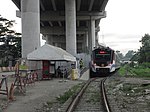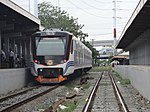PNR 8000 class
62.1 m (203 ft 8+7⁄8 in)
- 42 t (93,000 lb) (MeC)
- 37 t (82,000 lb) (T)
- MB-207 bolsterless (motor)
- TB-607 (trailer)
The PNR 8000 class (also known as the INKA DMUs together with PNR 8100 class) is a diesel multiple unit (DMU) train operated by the Philippine National Railways (PNR) since 2019.[5][6]
Operational history
Purchase
PNR signed a contract worth ₱485,312,600.00 (US$9.7 million) with the Indonesian firm Industri Kereta Api (PT INKA) on January 22, 2018, for the purchase of two sets of 3-car DMUs as part of the Reliability and Availability Program. The project was funded from the budget of the then-Department of Transportation and Communications (DOTC) as allocated in the 2015 General Appropriations Act.[7]
Delivery and commissioning
PNR took delivery of the 8000 class trains on December 11, 2019. These were inaugurated at Dela Rosa station on December 16, entering revenue service on the same day.[2] From that date until January 14, 2020, PNR offered free rides on these trainsets between Tutuban and FTI and vice versa, but with 20-passenger limit per station only.[8]
Initially, the trainsets were planned to reach Alabang station, but was delayed due to track obstructions and security problems.[9] A trial run to the Alabang station performed by an 8000 class train was conducted on March 1, 2020,[10] followed by passenger trial runs later that month.[11][12]
From December 2019 to March 2020, the trains serviced the Metro South Commuter line from Tutuban to FTI stations and vice versa, and since June 1, 2020, the trains now serve operations for the Metro North Commuter (MNC) line from Governor Pascual to Bicutan stations and vice versa.[13] While running from Governor Pascual to Bicutan, the LED screen displays the train going to FTI instead of Bicutan. Occasionally, the trains service the Metro South Commuter line when the Hyundai Rotem DMUs occupy the MNC services.[14]
As of April 2024, 8001 is serving the Calamba–Lucena Inter-Provincial Commuter service, while 8002 is serving the Bicol Commuter Line.
Design and features
The trains were manufactured by the Indonesian firm Industri Kereta Api, also known as INKA. The 8000 and 8100 DMUs and the 8300 class coaches are all given the designation K3 during their test runs in Indonesia.
Car body
The design of the 8000 class was based from PT Kereta Api's existing EA203 series electric multiple units (EMUs), Minangkabau Express, Adi Soemarmo International Airport Railink, Yogyakarta International Airport Railink & Solo Express diesel electric multiple units (DEMU), but the number of doors were increased from two to three double-leaf sliding doors per side.
The livery consists of a white body with a black design in the windows and blue stripes underneath it. The driver cabs, on the other hand, have a black and orange design with the PNR logo underneath the windshield.
Interior
The trains are the first in the entire PNR system to feature an LED passenger information system display in each train car. Seats are colored orange and longitudinal-type.
The design capacity of a three-car trainset is 750 passengers.[2]
Incidents and accidents
After the inauguration of the 8000 class, multiple stoning incidents were recorded in December 2019. The old trains were involved at the incidents such as the PNR Hyundai Rotem DMU, 203 series, and the KiHa 35. The 8000 class were also involved at the stoning incident. The cause of the incidents were from a group of minors that throw stones and sometimes used a slingshot.[15][16]
- 14 stoning incidents were reported from December 2 to 21, 2019, including a stoning incident in one 8000 class train.[17]
- On December 28, 2019, an 8000 class was obstructed between España and Sta. Mesa stations.[18]
- 8001 hit a car at the railroad crossing in Brgy. Masaya, Bay, Laguna on July 30, 2023.[19]
Gallery
-
 An 8000 class with its cowcatcher removed at Sangandaan station.
An 8000 class with its cowcatcher removed at Sangandaan station. -
 The LED screens of the 8000 class.
The LED screens of the 8000 class. -
 An 8000 class train at FTI station in December 2019.
An 8000 class train at FTI station in December 2019. -
 An 8000 class train at Santa Mesa station in February 2020.
An 8000 class train at Santa Mesa station in February 2020. -
 An 8000 class train during its test run in Indonesia in July 2019.
An 8000 class train during its test run in Indonesia in July 2019.
See also
References
- ^ "Diesel Multiple Unit Philippine National Railways". www.inka.co.id. Retrieved December 11, 2021.
- ^ a b c "PNR deploys new Indonesian-made trains". ABS-CBN News. December 16, 2019. Retrieved May 10, 2021.
- ^ "フィリピン国鉄(PNR)8000・8100 Series". 2427junction.com (in Japanese). Retrieved December 11, 2021.
- ^ "Diesel Generator Set QSN14 Series" (PDF). Cummins. Retrieved December 22, 2021.
- ^ Philippine News Agency (December 16, 2019). "New PNR railcars make inaugural run". www.pna.gov.ph. Retrieved February 10, 2020.
- ^ "PNR unveils 2 brand new diesel multiple unit trains bought from Indonesia". Manila Standard. Retrieved February 3, 2020.
- ^ "DOTr- PNR Signs Contract To Acquire 2 New Trainsets from Indonesia" (Press release). Department of Transportation. January 22, 2018. Retrieved December 11, 2021.
- ^ mmz 919 (December 18, 2019). Riding the new PNR PT INKA DHMU: mmz 919 Mini Vlog #1. YouTube. Event occurs at 2:34. Retrieved May 10, 2021.
{{cite AV media}}: CS1 maint: numeric names: authors list (link) - ^ Lalu, Gabriel Pabico (December 11, 2019). "New trains won't reach Alabang station, PNR cites track obstruction, security problems". INQUIRER.net. Retrieved March 4, 2021.
- ^ "Inka DMU first time at Alabang". YouTube. September 14, 2020. Retrieved February 21, 2021.
- ^ PNR PT INKA DHMU 8000 Series TS 1 (8001) First-ever Commercial Run from Alabang arriving Bicutan Stn. YouTube.
- ^ PNR PT INKA DMU 8002 cruising at the Posadas Vicinity of the PNR Line | March 13, 2020. Facebook.
- ^ PNR Trains at Bicutan Station Vicinity on GCQ Day 21 [PART 1: PT INKA DHMUs]. YouTube. Retrieved December 31, 2021.
- ^ PNR PT INKA DHMU 8000 Series in Metro South Commuter Service Compilation (October 13, 2020). YouTube. Retrieved December 31, 2021.
- ^ Aquino, Vick (February 23, 2020). "PNR nababahala na sa pambabato sa mga tren". Abante TNT. Retrieved December 31, 2021.
- ^ "DOTr appeals to the public to report PNR stone-throwing incidents". CNN Philippines. December 28, 2019. Archived from the original on December 28, 2019. Retrieved December 31, 2021.
- ^ Panganiban-Perez, Tina (December 26, 2019). "Trains damaged in 14 stone-throwing incidents in December 2019, says PNR". GMA News. Retrieved December 30, 2021.
- ^ SONA: Yero, gulong at iba pang basurang puwedeng makasira sa tren ng... (YouTube). December 30, 2019. Retrieved December 30, 2021.
- ^ "train accident dito sa Brgy. Masaya, Bay, Laguna..." PTERC Facebook Group. July 30, 2023. Retrieved August 8, 2023.
External links
 Media related to PNR 8000 class at Wikimedia Commons
Media related to PNR 8000 class at Wikimedia Commons
- v
- t
- e
| |||||
Metro Rail Transit Systems | |||||
|---|---|---|---|---|---|
| |||||
| |||||||||||
- Names in Italics are either decommissioned or not yet in service.
















